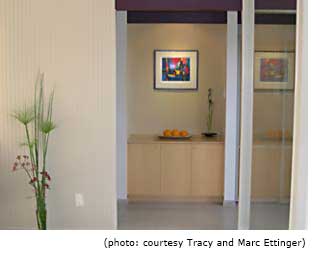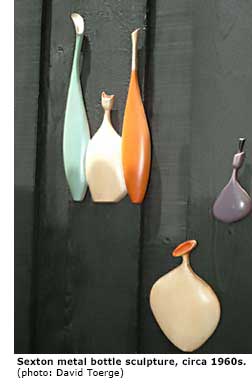Wall Art: The House Awakens - Page 3

Colors can be grouped in terms of the emotion they evoke. Cool colors of blue, green, turquoise, and silver are calming, while the warm colors of red, pink, yellow, gold, and orange are exciting. Neutral colors, such as brown, beige, ivory, gray, black, and white are considered unifying and help the viewer to focus on the colors that surround them.
Photographs, especially black and white ones, are also popular with Eichler owners. Jeffrey Moreno, a designer with Atherton Kitchen Design Studio, points out that when selecting photographs for an Eichler, the framing is very important to the overall look and compatibility to the space. "Most important is to have plain, simple white or black framing," says Moreno. "You don't want anything that is heavy, and it should be as thin as possible. One classic look is white matting with a simple black metal frame. This works very well. Also, brushed aluminum and silver frames work well, since they provide an industrial look."
Nagwani agrees that simplicity is important, and notes even potentially greater results when simplicity is combined with the concept of repetition. "Great and inexpensive art for Eichlers," Nagwani points out, "are black and white family photos in simple black frames with white matte. To have a series of them on the wall is visually beautiful and effective in Eichler homes, because of the geometric aspect and the fact that all of the photos are related."
Once you have searched for and found a piece of art that you like, it is time to decide where to place it. The 'art of placing art' can be quite a mystery, but the experts provide helpful advice. Moreno points out that one place to start is at the fireplace. "It makes a great focal point," he says. "One large piece over the fireplace can make an impressive design statement. Other ideal placements include positioning one large piece on an open, bare wall or over the sofa." Stratton agrees. "One very large piece works well, or a series of similar-sized solid pieces," she claims. "When using a grouping of smaller pieces, I like to keep them all in the same size or color palette, so there's a sense of continuity between each piece. What this does is to embrace the geometric simplicity of the Eichler."

The proper height to hang your artwork is an individual decision and depends on the art and the location. However, the most common rule of thumb is the '60-inch rule'—that in general, it is good to start by placing the piece so that its center is just at or slightly above eye level, or about 60 inches from the floor. In addition, Moreno stresses the importance of creating negative space around the art. "Negative space is very important to the Eichler design," says Moreno. "A lot of Eichler's design concept is about appreciating the architecture of the space, so that you are looking at the entire space—not just the art, but also the space around the art. Art surrounded by negative space makes a stronger focal-point statement than when it covers the wall."
The proper amount of negative space varies and will depend on the art piece. According to Moreno, "If your art is busy, or has a lot of color or texture, you need more negative space." As a rule of thumb, he recommends striving for at least 12 inches of negative space on each side and between eight and 12 inches on the bottom. "If you want a gallery look," Moreno says, "you can almost span floor-to-ceiling if you have proper lighting. You just need to be careful that the art does not overwhelm the space." For those who want more flexibility in the placement of art, try positioning free-standing pieces on a mantel, a free-floating shelf, a chair, an easel, or a console table.
One does not have to spend a lot of money on Eichler-compatible art. Our experienced collector resource for original art works claims that "you can get into real good art for anywhere from $500 to $5,000. And if you are thinking of it as an investment, you should try to buy the best thing you can afford, keeping in mind that one great piece is better than five lesser ones." For those that love the search for the ultimate bargain, try local garage sales, flea markets, or even eBay. Finding art through these channels can be fun, and can even provide one opportunities to learn the stories behind the pieces of art.





